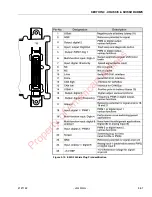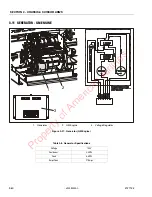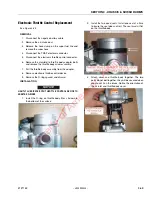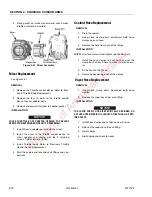
SECTION 3 - CHASSIS & SCISSOR ARMS
3121133
– JLG Sizzor –
3-63
Air Fuel Mixer
The air valve mixer is an air-fuel metering device and is
completely self-contained. The mixer is an air valve
design, utilizing a relatively constant pressure drop to
draw fuel into the mixer from cranking to full load. The
mixer is mounted in the air stream ahead of the throttle
control device.
When the engine begins to crank, it draws in air with the
air valve covering the inlet, negative pressure begins to
build. This negative pressure signal is communicated to
the top of the air valve chamber through 4 vacuum ports in
the air valve assembly. A pressure/force imbalance begins
to build across the air valve diaphragm between the air
valve vacuum chamber and the atmospheric pressure
below the diaphragm. The air valve vacuum spring is cali-
brated to generate from 4.0 inches (101.6 mm) of water
column at start to as high as 14.0 inches (355.60 mm) of
water column at full throttle. The vacuum being created is
referred to as Air Valve Vacuum (AVV). As the air valve
vacuum reaches 4.0 inches (101.6mm) of water column,
the air valve begins to lift against the air valve spring. The
amount of AVV generated is a direct result of the throttle
position. At low engine speed the air valve vacuum is low
and the air valve position is low thus creating a small ven-
turi for the fuel to flow. As the engine speed increase the
AVV increases and the air valve is lifted higher thus creat-
ing a much larger venturi. This air valve vacuum is com-
municated from the mixer venture to the LPR secondary
chamber via the low pressure fuel supply hose. As the
AVV increases in the secondary chamber the secondary
diaphragm is drawn further down forcing the secondary
valve lever to open wider.
Electronic Throttle Control (ETC)
Engine speed and load control is maintained by an ETC
device. Speed and load control are determined by the
ECM. Defaults programmed into the ECM software and
throttle position sensors allow the ECM to maintain safe
operating control over the engine. The Electronic Throttle
Control device or "throttle body assembly" is connected to
the intake manifold of the engine. The electronic throttle
control device utilizes an electric motor connected to the
throttle shaft. When the engine is running electrical signals
are sent from the equipment controls to the engine ECM
when the operator depresses an equipment function
switch. The ECM then sends an electrical signal to the
motor on the electronic throttle control to increase or
decrease the angle of the throttle blade thus increasing or
decreasing the air/fuel flow to the engine.
The electronic throttle control device also incorporates
two internal Throttle Position Sensors (TPS) which provide
output signals to the ECM as to the location of the throttle
shaft and blade. The TPS information is used by the ECM
to correct speed and load control as well as emission con-
trol.
Figure 3-31. Air Fuel Mixer
Figure 3-32. ETC throttle control device
Property of American Airlines
Содержание 3394RT
Страница 2: ...P r o p e r t y o f A m e r i c a n A i r l i n e s...
Страница 26: ...SECTION 1 SPECIFICATIONS 1 16 JLG Sizzor 3121133 NOTES P r o p e r t y o f A m e r i c a n A i r l i n e s...
Страница 124: ...SECTION 3 CHASSIS SCISSOR ARMS 3 88 JLG Sizzor 3121133 NOTES P r o p e r t y o f A m e r i c a n A i r l i n e s...
Страница 178: ...SECTION 5 JLG CONTROL SYSTEM 5 24 JLG Lift 3121133 NOTES P r o p e r t y o f A m e r i c a n A i r l i n e s...
Страница 227: ...P r o p e r t y o f A m e r i c a n A i r l i n e s...

































